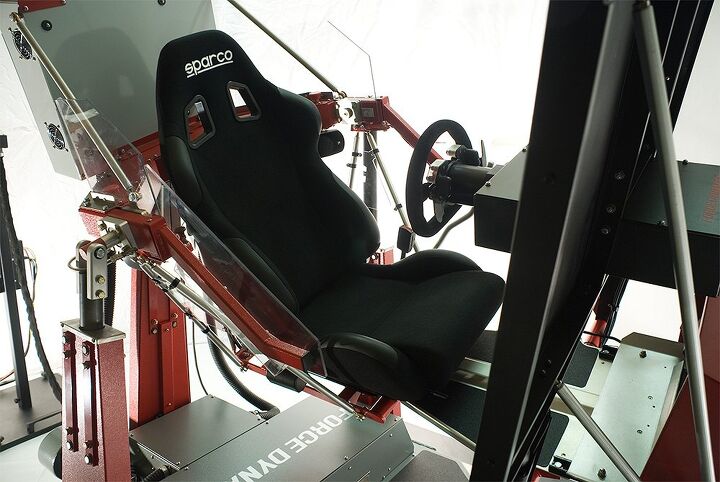TTAC Reader Pits Simulated MX-5 Against the Real Deal [with Video]
My company, Force Dynamics, builds full-motion driving simulators. They work by tilting you as the simulated vehicle corners or accelerates, so your brain is tricked into feeling lateral or longitudinal accelerations.
Sometimes people who watch our machines in action say, “This is moving way too much!” So when we started racing a Mazda Miata in the ChumpCar World Series, I decided to conduct an experiment.
The result: a comparison of the forces you feel while driving a race car with the forces you feel while driving our motion systems. The phone, like your inner ear, can’t tell the difference between being accelerated or tilted. What you see on the phone in each half of the video is what I was feeling in the real car and in the simulator.
How do the two experiences compare? Practicality limits the simulator’s sustained force to about .6 g. Luckily, your perception is enhanced a bit: in the simulator, the force keeping you in the seat gets lower as you tilt, whereas in real life that force is always 1 g, so you feel more “oomph” for a given load in the simulator than you do in real life. There’s also a psychological component. You’re seeing yourself cornering, and you’re getting other secondary cues, too: in the 401cr, your rate of rotation; vibration; sound and fury.
How do the two differ? Well, the real car is easier: your positional awareness is better, and the onset cues are sharper, so it’s easier to read the car on turn-in. Those differences aside, however, I was almost immediately comfortable making the transition to real driving. Shifting, braking, cornering, and handling the car on the limit all made nearly direct transitions to the track; for example, I was immediately comfortable holding the car at small slip angles through long, fast corners, because it behaved exactly like I expected it to.
What this means is while the simulator can’t fully match the sustained accelerations of a real car, the overall feel can be very good, and a high-quality motion platform can help immensely in the transition from simulator to track.
If you have any questions, feel free to ask in the comments.
Submitted by David Wiernicki. You may know him as B&B member PeriSoft in the comments.
More by Ur-Turn
Latest Car Reviews
Read moreLatest Product Reviews
Read moreRecent Comments
- Rover Sig 2021 Jeep Grand Cherokee Limited, like my previous JGC's cheap to keep (essentially just oil, tires) until recent episode of clunking in front suspension at 50K miles led to $3000 of parts replaced over fives visits to two Jeep dealers which finally bought a quiet front end. Most expensive repair on any vehicle I've owned in the last 56 years.
- Bob Hey Tassos, have you seen it with top down. It's a permanent roll bar so if it flips no problem. It's the only car with one permanently there. So shoots down your issue. I had a 1998 for 10 years it was perfect, but yes slow. Hardly ever see any of them anymore.
- 3-On-The-Tree 2007 Toyota Sienna bedsides new plugs, flat tire on I-10 in van Horn Tx on the way to Fort Huachuca.2021 Tundra Crewmax no issues2021 Rav 4 no issues2010 Corolla I put in a alternator in Mar1985 Toyota Land Cruiser FJ60 280,000mi I put in a new radiator back in 08 before I deployed, did a valve job, new fuel and oil pump. Leaky rear main seal, transmission, transfer case. Rebuild carb twice, had a recall on the gas tank surprisingly in 2010 at 25 years later.2014 Ford F159 Ecoboost 3.5L by 80,000mi went through both turbos, driver side leaking, passenger side completely replaced. Rear min seal leak once at 50,000 second at 80,000. And last was a timing chain cover leak.2009 C6 Corvette LS3 Base, I put in a new radiator in 2021.
- ChristianWimmer 2018 Mercedes A250 AMG Line (W177) - no issues or unscheduled dealer visits. Regular maintenance at the dealer once a year costs between 400,- Euros (standard service) to 1200,- Euros (major service, new spark plugs, brake pads + TÜV). Had one recall where they had to fix an A/C hose which might become loose. Great car and fun to drive and very economical but also fast. Recently gave it an “Italian tune up” on the Autobahn.
- Bd2 Lexus is just a higher trim package Toyota. ^^


































Comments
Join the conversation
Two words: that is super cool.
Hey guys - I'm the guy from the article there (and the Chump in the car). If anyone has any questions, fire away! As for the ones already asked... yeah, it's more expensive than a Chump Car, though I have to say it's probably not THAT much more than all the costs of a few guys running Chump for a couple of years. As for pricing, think about a 5-series. Not the one with pleather and manual mirrors; the one you'd actually drive. So yeah, it's not super cheap. But like I said, if you take running costs into consideration, it starts to look reasonable again, especially if you're comparing it to something like running SCCA regionals: Good luck pulling that off (in most any class) for under fifty grand a year. And then there's the thing I tell people on YouTube: You can crash a simulator more than once!